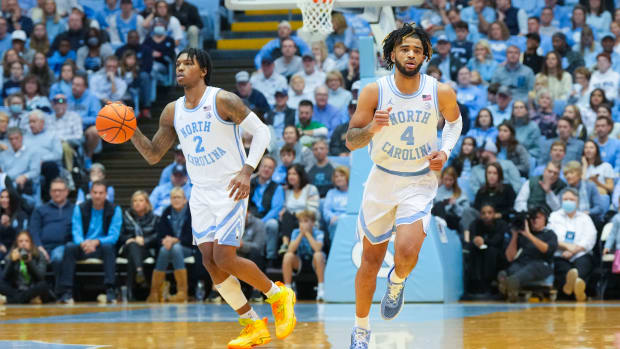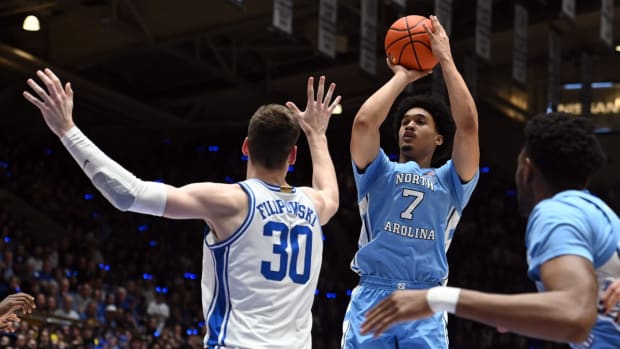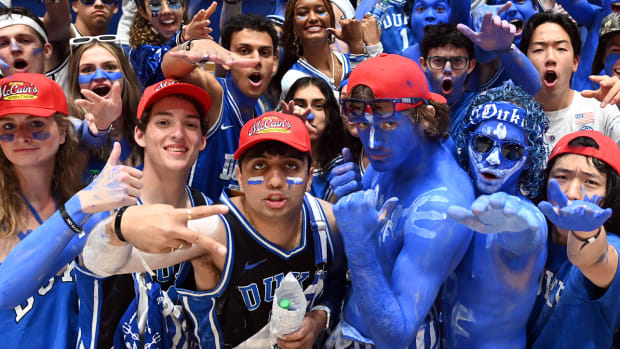UNC Needs More Wing Scoring in 2020
Among the many issues that plagued North Carolina last year, inconsistency with scoring on the wing was high on the list.
There is no doubt that some of that to do with injury. Brandon Robinson was consistently hurt, and Anthony Harris tore his ACL after showing promise early on. Leaky Black was also recovering throughout the summer after an injury-riddled first year in Chapel Hill.
The Tar Heels were also fresh off of losing Cam Johnson, Luke Maye, Kenny Williams, and Nassir Little in one offseason. Johnson was one of the most reliable shooters in the country, while Maye was an All-American in 2018. Williams and Little were less consistent, but still posed major threats at times.
For the 2020-21 campaign, scoring from the wing is still a question mark. Brandon Robinson was the best option last year, and he graduated this spring.
Why is wing scoring so important for this team?
Well, with an extremely talented frontcourt, it will be vital to allow those post players to operate with space. If teams don’t trust UNC to knock down shots or reliably drive to the basket, they will play heavy help defense and make it much more difficult to get one-on-ones and room down low.
There is also the case of the ball handler. Who the starting point guard will be next season is still yet to be seen, but there is a good chance that it will be a freshman. As good as Caleb Love might be, he will need help. A consistent wing threat will give the primary ball handler time to operate and swing the ball around. This is part of the reason Cole Anthony got so isolated last year. Given that he was the primary scorer and didn’t have much help on the perimeter, he was almost always the major focus of an opponent’s defense. This led to a lot of iso-ball and forced shots and passes.
Who could step up?
Leaky Black is the obvious candidate to take a leap on this roster. It has been a bit of a rollercoaster for Black so far, but he still has plenty of potential. Last year his minutes and scoring went up, but his efficiency took major hits. As a sophomore, he averaged 6.5 points, 2.6 assists and 3.6 rebounds. His field goal percentage dropped from 47% to 36%, with his three-point percentage dropping from 41.7% to 25.4%.
Black has the tools to be a good defender, but still has a way to go to be a lockdown player on the perimeter. A starting spot is his to lose, but in order to be a big-time contributor his scoring needs to elevate. Last year he took a lot of low-percentage shots and seemed rushed at times. Black’s progression will be vital for North Carolina. It will be interesting if he can turn those flashes into a consistent product.
Anthony Harris showed a lot of promise in the short time he had last year. He played in just five games before tearing his ACL against Yale, and he missed the first month of the season as well. Each game he looked more comfortable out on the court. He averaged 6.8 points in only 12 minutes a game and shot 12/22 (54.5%) from the floor. If he can continue to work on his natural scoring ability and knock down the three-ball, he could have a big role next year. He is expected to ready to go and he will surely be wanting to prove himself.
Andrew Platek is entering his senior season in Chapel Hill and he has yet to find his groove from behind the arc. He made 167 threes in his two varsity years at Northfield Mount Hermon High School and earned a reputation for himself as a shooter. However, he has only hit 28 threes on a career 28.3% in three years at Carolina. Confidence is important for a shooter, and there is nothing stopping Platek from having a big-time year in his final season. He will have to fight for minutes despite being a senior, and how he shoots could determine just how much he sees the floor.
Walker Kessler is an interesting player to have on this list. Yes, he is listed as a center and is 7 feet tall. He is here is because of his versatility on offense. Currently, he is not a lights-out shooter from deep. But he absolutely has the ability to knock down the three-ball and that is something very rare to a North Carolina frontcourt. Kessler said UNC coaches showed him plenty of film of Luke Maye and told him that’s how they want to use him, which was a major selling point in Kessler’s commitment.
Maye played most of his minutes at the four, and that is a something we could see Kessler doing. With a loaded frontcourt, Roy Williams will have to use his big men in creative ways. Kessler could have more impact on the wing than some anticipate.
The last two are freshmen Puff Johnson and Kerwin Walton. How much playing time they will see is unclear. Much of it will have to do with camp and how they adjust to the speed of the college game. Both bring a needed skillset.
Walton is reminiscent of Kenny Williams. Shooting needs to be a major asset if he wishes to get minutes early on, but he also shows long-term potential as a defender and team player. The only issue with his style of play is that it doesn’t lend itself to making a splash in his first year. He has a chance of being a great player, but he will mostly likely have to spend a lot of time learning in year one.
Johnson has less athleticism than Walton but has more length. He wants to be seen as more than a shooter as well and has potential as a well-round offensive player. Similarly, though, minutes next season could be dependent on just how well he gets the ball through the net. He, like Walton, will need time to iron out his game. However, with a strong impression they could both be seeing minutes next season.




